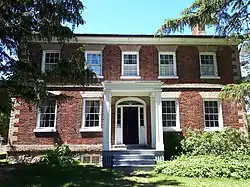 | |
| Location | 5172 Yonge Street Toronto, Ontario M2N 5P6 |
|---|---|
| Coordinates | 43°46′10.5″N 79°24′53″W / 43.769583°N 79.41472°W |
| Type | historic house museum |
| Website | Gibson House on toronto.ca |
| Official name | David Gibson House |
| Designated | 15 December 1980 |
Gibson House is a historical museum in Toronto, Ontario, Canada. It is located on Yonge Street, in the North York Centre neighbourhood of the former city of North York.
History
The property was first acquired by David Gibson, a Scottish immigrant, land surveyor, prior to the Rebellion of 1837. For his activities in the Rebellion, his house was destroyed and he was banished from Upper Canada. Gibson fled to nearby western New York, settling with his family in Lockport. Although he was threatened with losing his land, he continued to own the property in what was then York County, near Toronto. His wife was not banished, and she was able to travel between Lockport and Toronto to collect rents and profits on the farmstead.

In 1843, Gibson was pardoned, along with many who took part in the Rebellion. He returned with his family to York County in 1848 and built this house in 1851. Its style reflects a prosperous man, and some of its furniture and engravings reflect his U.S. residence in the motif.
Gibson House is set back from Yonge Street, one of the colony's pioneer roads and today often called the world's longest street. It is shielded from traffic, however, by construction hoarding for the Gibson Square Condominium development. Gibson House once welcomed carriages to its front door, now shielded from Yonge Street by construction. The house is one of the several museums operated by the City of Toronto.
Gibson established an apple orchard on the property in 1832, of which one tree remains at the corner of Yonge Street and Park Home Ave. The orchard (and the remaining tree) produce Tolman Sweet apples.[1][2] In 2016, the tree was selected as a winner in a local survey of Toronto trees as a "Survivor". Grafts from it have been used to propagate the species.[3]
Heritage Protection
The red brick Georgian Revival farmhouse[4] is protected under Part IV of the Ontario Heritage Act, designated by the former City of North York on December 15, 1980.[5] The bylaw notes "David Gibson House, 1851 designed by David Gibson. The building is recommended for designation on architectural grounds because it is a finely restored example of a Georgian dwelling. The well balanced, symmetrical front facade consisting of nine equally spaced windows is highlighted by the doorway with its semi-elliptical fan transom and two side lights. David Gibson was an early farmer and surveyor and as a politician was an ardent supporter of William Lyon Mackenzie. For his part in the successful rebellion Gibson's house was burned and it was not until he returned from the United States in 1849 that the present house was begun."[6]
The property is listed as a "Passport Place" by the National Trust for Canada, a featured historic site on their website.[7]
Programs
Tours are available, and a museum attached to the old house offers insight into the lives of a family which continued to reside here into the 20th Century. Children's programs welcome school groups and birthday parties, and certain days (e.g., First of July) offer guests a chance to play period games, sample kitchen treats, and help make ice cream.
Affiliations
The Museum is affiliated with: CMA, CHIN, and Virtual Museum of Canada.
See also
External links
References
- ↑ @GibsonMuseumTO (September 7, 2018). "This is the last remaining tree from the orchard that David Gibson established in 1832" (Tweet) – via Twitter.
- ↑ Hanes, Tracy (May 29, 2015). "Gibson Square revives historical spirit of North York". Toronto Star. Retrieved September 19, 2018.
- ↑ Geroge, Edith (February 21, 2016). "NATURAL ROOTS: The Tolman sweet apple at Yonge and Sheppard is the last tree from David Gibson's orchard". Toronto.com. Retrieved October 12, 2018.
- ↑ "Gibson House Museum - History". Gibson House Museum. City of Toronto. Retrieved October 12, 2018.
- ↑ "5172 YONGE ST". Toronto Heritage Register. Retrieved December 19, 2017.
- ↑ "CITY OF NORTH YORK, BY-LAW NUMBER 27975". by-law No. 27975 of December 15, 1980 (PDF). Retrieved June 11, 2018.
- ↑ "Gibson House Museum". National Trust for Canada. Retrieved September 15, 2018.